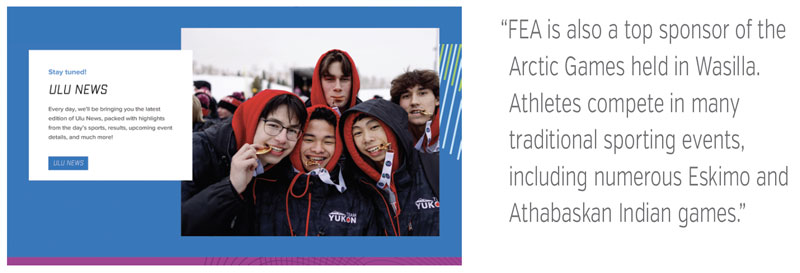Interview with Dave Cavitt
How Dave and Rachel Cavitt navigated Alaska’s retail challenges, positioning its Sadler’s Home Furnishings,
Williams &
Kay, Ultimate Mattress, Mattress Firm and Ashley Home Store brands for growth.
Furniture World caught up with Dave Cavitt sailing off the coast of Ketchikan, Alaska, which would be a mere
1,119 mile
car drive from his home base in Anchorage, were it not for the fact that Ketchikan is only accessible by sea and
air.
Furniture Enterprises of Alaska, based in Anchorage, is owned by Dave and Rachel Cavitt. The company operates 13
locations under the brands Sadler’s Home Furnishings, Ashley Home Store, Williams & Kay, La-Z-Boy, Mattress
Firm, and
Ultimate Mattress.
“Operating furniture stores in Alaska is a very different experience than in the lower 48. It’s big, has few
roadways
and is sparsely populated,” said Cavitt. “Only about 550,000 people can actually drive to our stores.
“Many places, including our capital, Juneau, don’t have road access. The Alcan Highway links the Lower 48 to
Alaska. The
roadway is still a little rough with long unpaved stretches and often minus 45-degree winter temps. Because of
that,
about 90% of goods are shipped by container ships or barges from Seattle to the Port of Anchorage. That makes
for
multiple complications. For example, Ashley can’t send us frequent smaller loads on their trucks.
Instead, they fill 53-foot trailers and deliver them to the port of Seattle. Most of our domestic product is
reloaded by
consolidators onto containers bound for Anchorage four times weekly. The cost to ship goods from Seattle to
Anchorage is
three times our current cross-Pacific cost, so we work hard to maximize every inch of space in those containers.
Bumpy Road
“I run the day-to-day business as president of the company,” he continued. “And when there are significant
decisions to
be made, Rachel, who has a very strong marketing mind, gives two cents and maybe a little bit more. She was
responsible
for positioning our store brands.
“What’s most important isn’t what’s written down in the employee handbook; it’s what owners and managers
actually do and
allow.”
“Before we founded FEA, she was an airline marketing executive. For many years, she did all of our new-hire
sales
training. Our daughter, Haley, studied business management at the University of Anchorage and participated in
the
debating world championships three times. Following graduation, she joined the business, working in multiple
departments.”
Dave Cavitt isn’t an Alaska native. He was raised in a farming community in the Central Valley of California and
became
intrigued with Alaska at an early age. “I knew I was going to live in Alaska,” he recalled. “A few days after
high
school graduation, I packed my backpack and hitchhiked there.
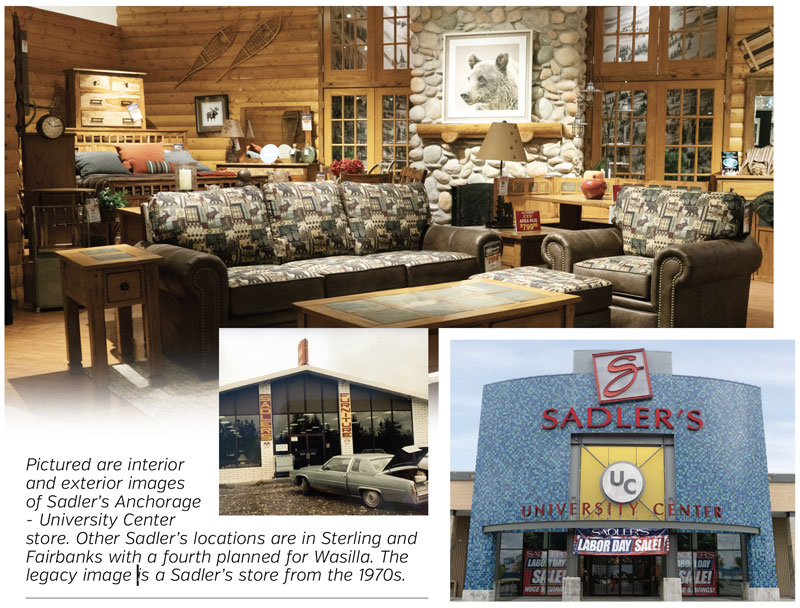
“Once in Anchorage, I held down a couple of odd jobs, including one painting a small furniture store. The owner,
Mr.
Sadler, was impressed with my work ethic and at 18 I became his second employee, handling warehouse and delivery
operations. After a few years, I started waiting on customers and was soon promoted to store manager. I became
the
general manager and partner when the business grew to four locations.
“In the early 1980s, the Alaskan economy was booming. People moved here for high-paying oil field and
construction jobs.
We bought bigger locations, thinking this growth would continue for years, financing buildings with low down
payments
and high interest rates. But the boom didn’t last. Construction stopped, thousands of jobs were lost, and people
moved
out of state, leaving behind foreclosed homes and failing banks.
“People also stopped buying furniture, and Sadler left the state to pursue new ventures. Rachel and I chose to
stay and
find a way out of the mess. We survived while most other local furniture stores did not.
“As terrible as the 1989 Exxon Valdez oil spill was, it created thousands of Alaskan jobs overnight and turned
the
economy around. We were able to purchase foreclosed properties we could never have afforded previously.”
“I knew I was going to live in Alaska. A few days after high school graduation, I packed my backpack and
hitchhiked
there.”
FEA’s Branding Strategy
Furniture World asked Cavitt why, instead of adding store locations under the banner of Sadler’s brand name,
Furniture
Enterprises of Alaska chose to create new store brands and add franchise store locations.
He explained that in the early ‘80s, Sadler’s had been a lower-end store with a strong brand identity in
Anchorage, home
to about 200,000 people, “Sadler decided to open a second higher-end location called Sadler’s Diamond, on the
far side
of town. The unexpected result,” said Cavitt, “was that our operating costs increased, but we didn’t gain
additional
business. The new store location confused our customer base. Upscale customers didn’t want to shop at Sadler’s
because
the brand was associated with promotional products.
“There are a few large furniture retailers like Nebraska Furniture Mart, that can be everything to everyone.
Instead, we
choose to introduce different store brands into our trading areas, each targeted to a different consumer
demographic.”
Cavitt explained that the book “Positioning: The Battle for Your Mind,” first published in the late 1970s,
helped
crystallize his thinking about brand expansion. “It talked about how a brand name can be devalued by extending
it too
far and explained how brands can stand out,” he recalled. “That was another reason we decided not to extend the
Sadler’s
brand name further.”
He went on to explain the roll-out and positioning of FEA’s individual brands.
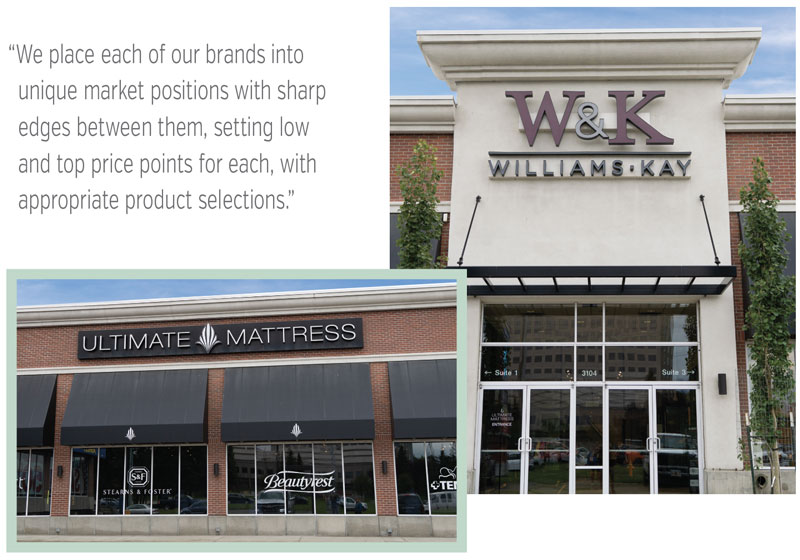
Williams & Kay: “Our first new store brand was Williams & Kay, which at the time featured a
Thomasville Gallery,
Flexsteel and other higher-quality lines. It was a hit. Today W&K carries Stickley, Hooker Furniture, some Amish
lines,
Bassett Upholstery, Natuzzi Editions, Jonathan Lewis, American Leather, Flexsteel, Canadel, and others.”
La-Z-Boy: “Next we located a La-Z-Boy gallery store next to our Sadler’s Anchorage location. The
addition increased
cross-shopping. Sadler’s didn’t lose any business, and the La-Z-Boy store did great!”
“Ashley’s current national directive is to move Ashley Home Stores up in price point. We plan to
backfill our starting
price point position by opening what we tentatively call ‘Outlet.”
Ultimate Mattress: “We have always been big believers in the potential of the mattress
business. To expand sales, we
followed the advice of researcher Britt Beemer, whose research suggested that if furniture retailers failed to
open
mattress specialty stores in their markets, their competitors would. So, we opened our Ultimate Mattress brand
store
close to Sadler’s. Ultimate Mattress did well, and Sadler’s mattress sales didn’t suffer.”
Mattress Firm: Later, Cavitt approached Mattress Firm to inquire about securing a franchise for
Alaska as a defensive
move. “We watched Mattress Firm’s growth,” he said, “and we knew it was just a matter of time before they opened
stores
in Alaska. So far, we have three Mattress Firm store locations.”
He added that the addition of Mattress Firm stores necessitated repositioning Ultimate Mattress’ product
selection. “It
serves the same higher-end clients as Williams & Kay, so, the store now features a starting Queen at about
$1,499 and,
at the top, a dual king Tempurpedic on an adjustable base for about $12,000. Also carried are the top ends of
the
Beautyrest Black, Purple, and Stearns & Foster lines.”
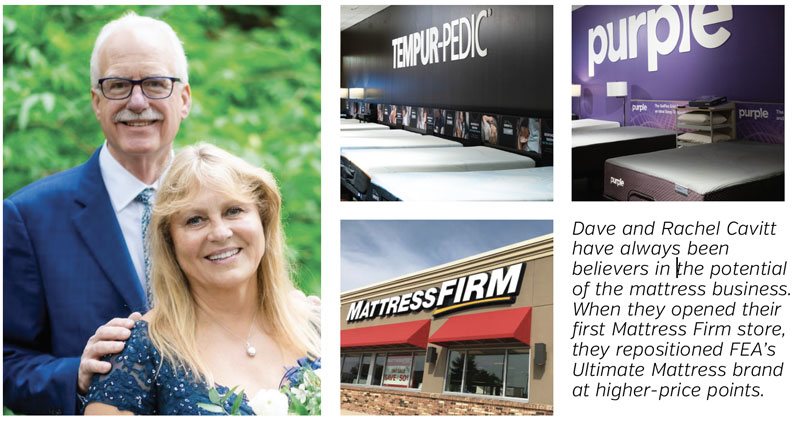
Ashley Home Stores: “When Ashley Furniture asked us to consider becoming the Ashley Home Store
licensee in Anchorage, we
said yes. Their quick shipping meant we could grow sales without expanding our warehouse.”
A New Concept Store For FEA: Cavitt explained, “Ashley’s current national directive is to move
Ashley Home Stores up in
price point. We plan to backfill this starting price point position by opening what we are tentatively calling
‘Outlet.’
It’s a new concept furniture and mattress store in Wasilla, a neighboring town 45 miles outside of Anchorage,
serving
budget-conscious customers moving into their first apartments and starter homes. Luckily, we found a suitable
100,000-square-foot building with room to house new Sadler’s and Ashley locations to facilitate cross-shopping.
We are
working with the talented store designer Jennifer Magee to renovate the space.
“Increased price points at Ashley will compete a bit more with Sadler’s, so we plan to add more solid wood
casegoods
selections to Sadler’s lineup and use the slogan, ‘For better quality home furnishings, step up to Sadler’s.’”
A Focus on Brand Positioning
“We place each of our brands into unique market positions with sharp edges between them, setting low and top
price
points for each, with appropriate product selections aligned to the needs and merchandised to appeal to
well-defined
customer groups,” noted Cavitt.
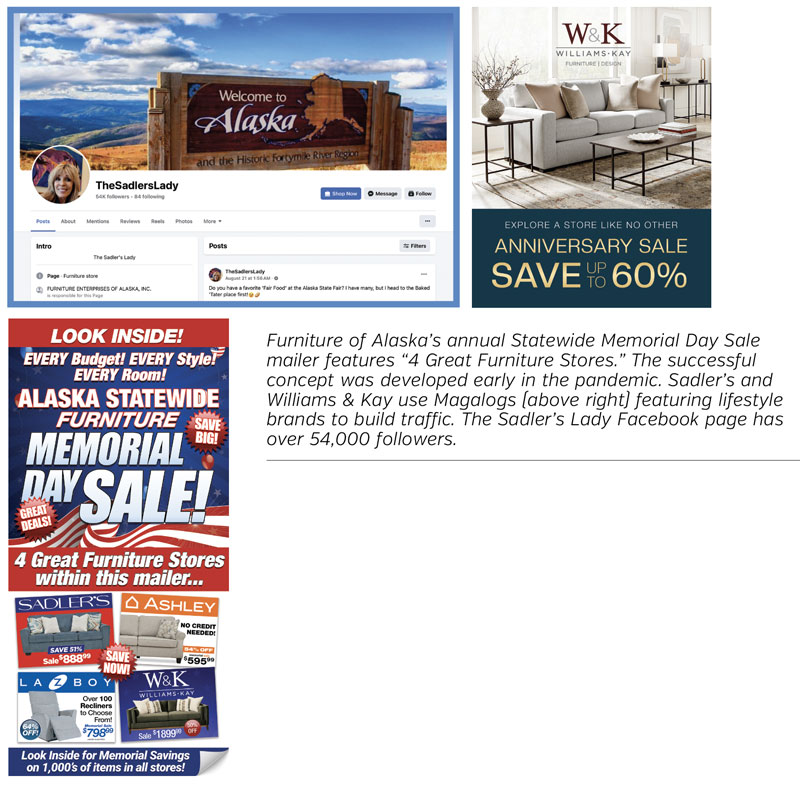
“For example, Williams & Kay’s bedroom displays feature king beds with a mix of other pieces, while Sadler’s
shows a
50/50 mix of king and queen beds. Our Ashley Home stores are merchandised with all queens with matching side
pieces
priced per group. Williams & Kay is more highly accessorized. Custom orders make up about 50% of its sales.
Sadler’s
custom order sales are about 20%, and since FEA’s Ashley Home Store customers want their purchases ASAP, its
custom
order percentage is negligible.
“Margaret Janke heads up our buying team. She’s logical, disciplined and does a great job. It’s amazing to watch
her
shop the High Point Market for lower-priced sofas and then quickly change gears and shop high-end Williams & Kay
vendors.”
Customer Service
Even though Furniture Enterprises of Alaska doesn’t have a formal customer service department, it provides great
customer service. “Over a decade ago, I concluded that the job description of everybody in our company includes
customer
service,” Cavitt recalled. “For us, customer service isn’t a department; it’s all of us.
“FEA serves a relatively small population, so we must get repeat customers. We also realize that upsetting
customers at
any of our stores may stop them from shopping at all of our stores. That’s why we try to be clear about our
policies.
Clarity is especially important for returns on stocked items. Our salespeople review those policies printed on
the back
of every sales order with customers before they sign off at the point of purchase. We never knowingly reject a
legitimate claim, but should a dispute arise, referring back to that signed policy statement usually clears up
any
misunderstanding.”
“We brought in a consultant to do kaizen events to create a culture of continuous improvement. FEA’s
employees became
more productive, and we were able to reduce staffing levels without sacrificing competitiveness.”
Delivery and Repair
Delivery and repair functions for FEA store brands are handled centrally.
“Let’s say we have a dozen stops on a particular day,” said Cavitt. “Three might be from Sadler’s, two from
Mattress
Firm, one from Ultimate Mattress, and the rest from Ashley Home Store, Williams & Kay, and La-Z-Boy. That way,
we can
route for efficiency. Customers are given a two-hour window two days in advance, and deliveries are made within
that
window over 99% of the time. Given the rough weather conditions in Alaska, that might seem surprising. Still, I
would
rather deliver in Alaska than deal with crowded city centers and bottlenecked freeways in other areas of the
country.
“FEA offers white glove delivery in Anchorage and the Wasilla area Tuesday through Saturday, as well as in
Fairbanks,
360 miles north of Anchorage, and the Kenai Peninsula area, 120 miles south of Anchorage.
“Outside of those areas, the population drops. Customers who live between Wasilla and Fairbanks must pick up
purchases
themselves or hire a third-party carrier to deliver,” Cavitt continued. “We deliver by air to the towns of Nome
and
Barrow, with populations of 2,500-3,000 people, five days a week and to smaller villages of 200 to 500 people
via
different air carriers that go to the smaller bush communities because roads don’t connect to these villages and
towns.
“We utilize our delivery staff to do repairs. If they can’t fix something, it’s returned to the warehouse, where
our
super-qualified shop techs make repairs.”
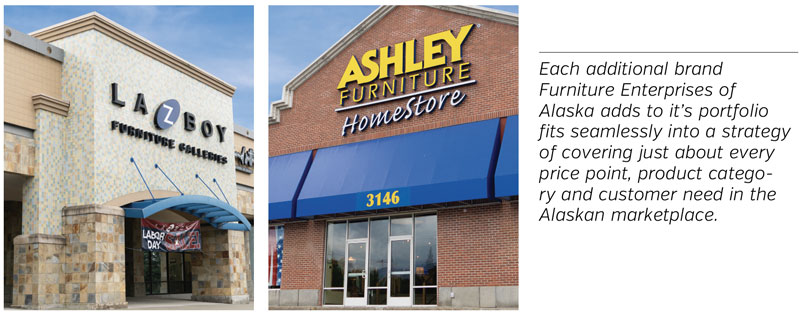
Kaizen & Staffing
“In 2015, we started having trouble finding people, especially to fill management positions. People got laid off
from
well-paying oil company jobs and moved out of Alaska. Our response focused on creating more efficient operations
and
increasing wages. We already had a solid benefits package, paying 75% of health insurance premiums, a 33% 401(k)
program
match up to 10% of wages, and two weeks of initial PTO that moves up to four weeks with seniority.
“We brought in a consultant to do kaizen events to create a culture of continuous improvement. The result was
that
Furniture Enterprises of Alaska’s employees became more productive, and we were able to reduce staffing levels
without
sacrificing competitiveness.
“That allowed us to pay more to attract good people. We also found that, as they became more efficient and we
measured
and communicated their productivity increases, it helped build a more positive company culture.
“Post-COVID management recruiting has continued to be a struggle, so we work with recruiter Bill O’Malley to help
us
fill open positions. This is primarily because we don’t have a large enough pool of furniture talent here in
Alaska not
already working for FEA.”
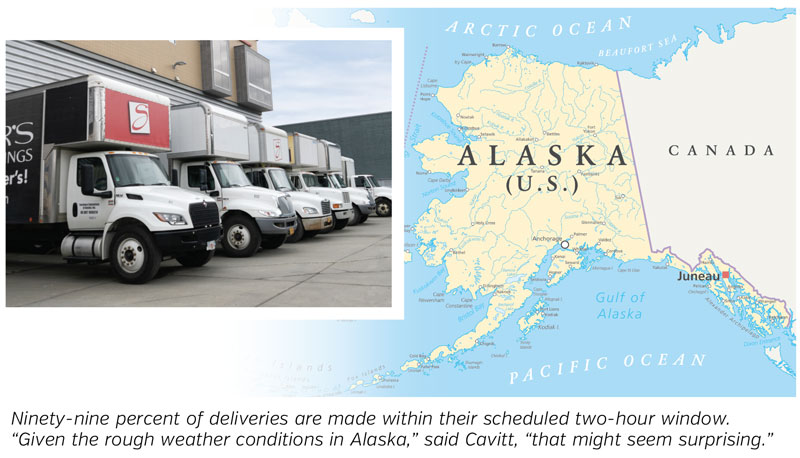
Advertising
Furniture of Alaska used television years ago almost exclusively, buying larger contracts and dividing spots
between its
brands. “It was efficient in that way,” Cavitt said. “But after doing a large kaizen study to measure which
media
brought in customers, we dropped most of our television and radio advertising in favor of direct mail and
every-door
direct print campaigns. That’s still working for us.
“At first, during the Pandemic, like many retailers, we cut back advertising expenses by sending out two
four-page
broadsheets nested together to make an eight-page mailer. The first headline read, ‘Alaska Statewide Furniture
and
Mattress, Memorial Day Event.’ Sadler’s, Ashley, La-Z-Boy, Williams & Kay, Ultimate Mattress and Mattress Firm
were
allocated space proportionately to their sales volumes. That worked surprisingly well, and so we continue to run
that
promotion.
“In addition, Sadler’s and Williams & Kay send out magalogs featuring lifestyle images of brands like Stickley,
Bassett,
and Fusion Designs Amish.” Cavitt also mentioned that he plans to develop a playbook to ramp up his digitally
integrated
postcard marketing by the end of this year. “We buy Google Ad Words and do everything we can to ensure that all
of our
brands’ websites appear as near to the top as possible on the first page of Google results when consumers are
looking
for furniture in Alaska.”
He’s less excited about the benefits of digital advertising. “Members of the performance group we belong to
through
Impact Consulting probably get tired of hearing me say that I don’t like digital advertising. The group includes
retailers Pilgrim Furniture, Matter Brothers, Turner’s Furniture, Woodstock Furniture, Howell Furniture, Stacy’s
Furniture, Schneiderman’s, Seldens Furniture and Woodbridge Interiors. It’s my view that people involved in
digital
marketing think they know what they are doing, but many don’t. They might tell me we received two million
impressions,
but at least in our market, we don’t see digital campaigns moving our traffic numbers.”
However, Sadler’s is getting excellent results from Facebook. “When we cut back on our broadcast television
spend, our
long-time Sadler’s television spokesperson, Victoria Rivera, transitioned to working on the Sadler’s Lady Facebook page, currently with over 54,000
followers. She posts inspirational messages,
interesting tidbits, winners of our weekly furniture giveaway Super Sadlersday Event! and lots more. She has a
great
time doing it, and the page doesn’t come across as pushing product.
“When she posts pictures of items we’re considering buying at Market, we might get a thousand people weighing in,
telling us, “Oh, yeah, we think that’d be great.” Or, “Oh no, what could you be thinking?” For the most part,
those
comments have helped us improve our buying batting average.”
Community Involvement
“Sadler’s has sponsored Go Red for Women in Anchorage and Fairbanks for a decade. Go Red’s mission is to fund
research,
education, and prevention of women’s heart disease.”
FEA was also a top sponsor of the 2024 Arctic Games held in Wasilla.” Cavitt said, “Athletes from Alaska, Canada,
Greenland, Finland and Norway compete in many traditional sporting events, including numerous Eskimo and
Athabaskan
Indian games.”
He has served on the executive committee of the Anchorage Economic Development Corporation (AEDC) and was a past
president of the National Home Furnishings Association, a predecessor organization of the Home Furnishings
Association
(HFA).
Ethics & Conduct
Concluding his remarks, Cavitt advised, “What’s most important isn’t what’s written down in the employee
handbook; it’s
what owners and managers actually do and allow. Any company that isn’t honest with its customers will suffer
from
employees who cheat the company they work for. I believe it’s important for store owners and managers to treat
staff
with fairness, honesty, and never ask them to do anything they wouldn’t do themselves.
